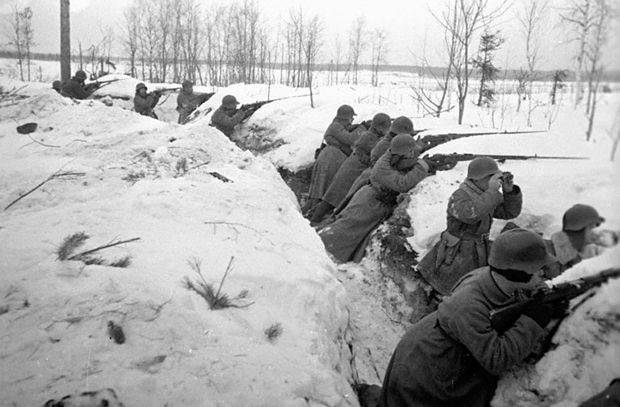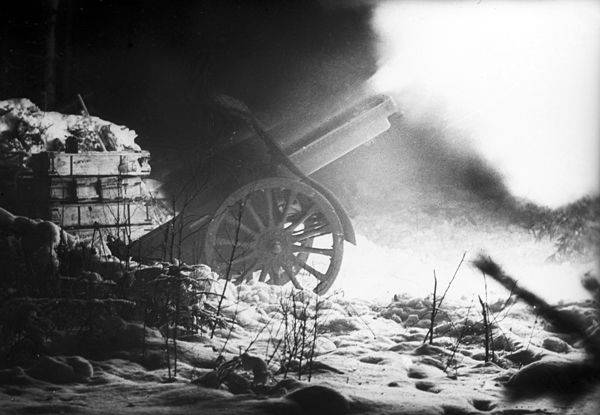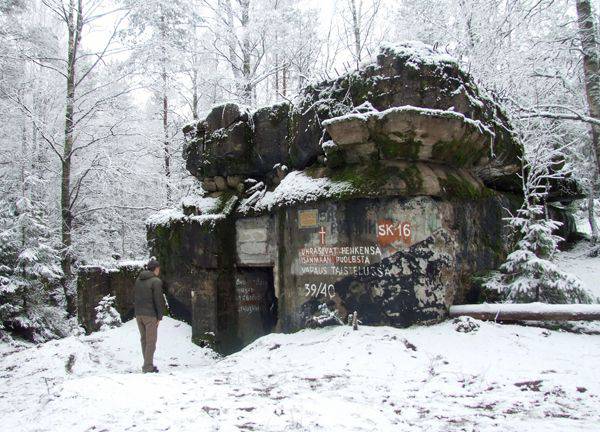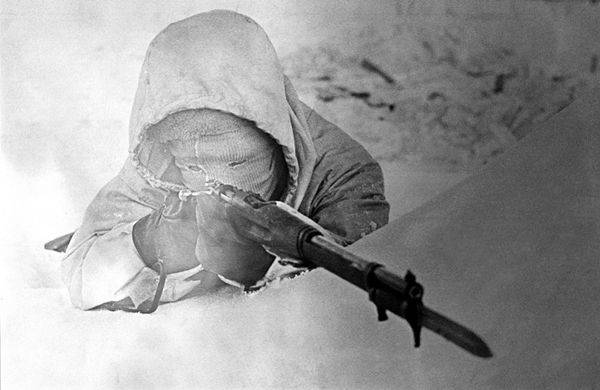10 Remarkable Facts About the 1939 – 1940 Soviet-Finnish War

Little-known details of the military campaign, which eclipsed the Great Patriotic War
This year, November 30, 76 will mark the years since the beginning of the Soviet-Finnish war of 1939 – 1940, which in our country and beyond it is often called the Winter War. Unleashed right on the eve of World War II, the Winter War remained in its shadow for a very long time. And not only because the memories of her were quickly eclipsed by the tragedies of the Great Patriotic War, but also because of all the wars in which the Soviet Union participated in one way or another, this was the only war initiated by Moscow.
Move the border to the west
The winter war became literally “a continuation of politics by other means.” After all, it began right after several rounds of peace negotiations were stalled, during which the USSR tried to move the northern border as far as possible from Leningrad and Murmansk, instead of offering Finland land in Karelia. The Maynil incident became an immediate pretext for the outbreak of hostilities: artillery shelling of Soviet troops on the border with Finland on November 26 1939 of the year, which resulted in four soldiers. Moscow placed responsibility for the incident on Helsinki, although later the fault of the Finnish side was subject to reasonable doubts.

Four days later, the Red Army crossed the border of Finland, thus starting the Winter War. Its first stage - from November 30 1939 to February 10 1940 - was extremely unfortunate for the Soviet Union. Despite all the efforts, the Soviet troops did not succeed in breaking through the Finnish defense line, which by that time was already called Mannerheim’s line with might and main. Moreover, during this period, the deficiencies of the existing system of organization of the Red Army were most clearly manifested: poor controllability at the middle and junior level and lack of initiative among the commanders of this level, poor communication between units, types and types of troops.
The second phase of the war, which began on February 11 on the 1940 of the year after a massive ten-day preparation, ended in victory. Until the end of February, the Red Army managed to reach all those lines that it planned to reach before the new year, and push the Finns back to the second line of defense, constantly creating a threat to the encirclement of their troops. 7 March 1940, the Finnish government sent its delegation to Moscow to participate in peace negotiations, which ended with the conclusion of a peace treaty on March 12. It stipulated that all the territorial claims of the USSR (the ones that were discussed at the talks on the eve of the war) would be satisfied. As a result, the border on the Karelian Isthmus moved away from Leningrad to 120 – 130 kilometers, to the Soviet Union the whole Karelian Isthmus with Vyborg, the Vyborg Bay with islands, the western and northern shores of Lake Ladoga, a number of islands in the Gulf of Finland, part of the Rybachiy Peninsulas, and the Peninsula, and a half of the peninsula, Hanko and the marine area around it were leased to the USSR for 30 years.
For the Red Army, victory in the Winter War came at a high price: irrecoverable losses amounted, according to various estimates, to 95 to 167 thousand people, about 200-300 thousand more were wounded and frostbitten. In addition, Soviet troops suffered heavy losses in equipment, primarily in tanks: Of the nearly 2300 tanks that went into battle at the beginning of the war, about 650 were completely destroyed and 1500 were destroyed. In addition, moral losses were also heavy: both the command of the army and the whole country, despite the massive propaganda, understood that the military force of the USSR needed urgent modernization. It began during the Winter War, but, alas, it was never completed until June 22, 1941.
Between truth and fiction
History and the details of the Winter War, which quickly faded in the light of the events of the Great Patriotic War, have since been revised and copied, refined and rechecked more than once. As it happens with any major historical events, the Russian-Finnish 1939 – 1940 war also became an object of political speculation both in the Soviet Union and beyond its borders - and remains to them to this day. After the collapse of the USSR, it became fashionable to revise the results of all key events in the history of the Soviet Union, and the Winter War was no exception. In the post-Soviet historiography, the Red Army’s casualty figures and the number of tanks and aircraft destroyed increased, while the Finnish losses, on the contrary, were significantly underestimated (despite even official data from the Finnish side, which remained almost unchanged against this background).
Unfortunately, the farther in time the Winter War moves away from us, the less chances are that someday we will know the whole truth about it. The last direct participants and eyewitnesses are passing away, in order to please the political winds, documents and material evidence are shuffled and disappear, and even new, often false, appear. But some facts about the Winter War are already so firmly fixed in world history that they cannot be changed for any reason. About ten of the most remarkable of them we will describe below.
Mannerheim Line
Under this name, a line of fortifications erected by Finland in the 135-kilometer stretch along the border with the USSR entered history. The flanks of this line rested on the Gulf of Finland and Lake Ladoga. At the same time, the Mannerheim Line had an 95-kilometer depth and consisted of three successive defense lines. Since the line, despite its name, began to be built long before Baron Karl Gustav Emil Mannerheim became commander-in-chief of the Finnish army, the main one in its composition was the old single-blooded long-term firing points (DOTs) capable of firing only frontal fire. There were about seven dozen of these in the line. Fifty more pillboxes were more modern and could fire on the flanks of the attacking troops. In addition, barrier lines and anti-tank facilities were actively used. In particular, in the support zone, there were 220 km of wire barriers in several dozen rows, 80 km of anti-tank granite snags, as well as anti-tank ditches, walls and minefields. Official historiography on both sides of the conflict emphasized that the Mannerheim Line was practically insurmountable. However, after the Red Army command system was rebuilt, and the tactics of storming the fortifications were revised and linked to preliminary artillery preparation and support by tanks, it only took three days to break through.

Finnish Democratic Republic
The day after the start of the Winter War, Moscow Radio announced the creation of the Finnish Democratic Republic in the city of Terijoki on the Karelian Isthmus. It existed as long as the war itself went on: until March 12 1940. During this time, only three countries in the world agreed to recognize the newly formed state: Mongolia, Tuva (at that time not yet part of the Soviet Union) and the USSR itself. Actually, the government of the new state was formed from its citizens and the Finnish immigrants living on the Soviet territory. He headed it, becoming at the same time Minister of Foreign Affairs, one of the leaders of the Third Communist International, a member of the Communist Party of Finland Otto Kuusinen. On the second day of its existence, the Finnish Democratic Republic concluded an agreement on mutual assistance and friendship with the USSR. Among its main points were taken into account all the territorial demands of the Soviet Union, which became the cause of the war with Finland.
Sabotage war
Since the Finnish army entered the war, although mobilized, but clearly losing the Red Army, both in numbers and technical equipment, the Finns relied on defense. And the so-called mine war, more precisely, the technology of continuous mining, became its essential element. As the Soviet soldiers and officers who participated in the Winter War recalled, they could not even imagine that practically everything that the human eye could see could be mined. “The stairs and thresholds of houses, wells, forest glades and edges, roadsides were literally littered with mines. Here and there bicycles, suitcases, phonographs, watches, wallets, cigarette cases were thrown about in a hurry. It was enough to move them, as the explosion was heard, ”they describe their impressions. The actions of Finnish saboteurs were so successful and revealing that many of their techniques were quickly adopted by the Soviet military and special services. We can say that the guerrilla and sabotage war that unfolded after a year and a half in the occupied territory of the USSR, to a large extent, was conducted according to the Finnish model.
Baptism of heavy KV tanks
One-tower heavy tanks of the new generation appeared shortly before the beginning of the Winter War. The first copy, which was actually a reduced version of the SMK heavy tank - "Sergey Mironovich Kirov" - and differed from it by the presence of only one tower, was made in August 1939 of the year. It was this tank that got to the Winter War to be tested in a real battle, which 17 of December went to during the breakthrough of the Hottinen fortified line of the Mannerheim Line. It is noteworthy that of the six crew members of the first KV, three were testers of the Kirov factory, which was engaged in the release of new tanks. The tests were considered successful, the tank showed itself from the best side, but the 76-millimeter cannon, which he was armed with, turned out to be not enough to fight the pillboxes. As a result, the KV-2 tank, which was armed with an 152-millimeter howitzer, which no longer had time to take part in the Winter War, but was forever in the history of world tank design, was hastily developed.
How England and France prepared to fight the USSR
London and Paris supported Helsinki from the very beginning, although they did not go further than military-technical assistance. In total, England and France, along with other countries, handed over 350 combat aircraft to Finland, approximately 500 field guns, over 150 thousands of firearms weapons, ammunition and other ammunition. In addition, volunteers from Hungary, Italy, Norway, Poland, France and Sweden fought on the Finnish side. When at the end of February the Red Army finally broke the resistance of the Finnish army and began to develop an offensive inland, Paris began to openly prepare for direct participation in the war. 2 March France announced its readiness to send an expedition corps to Finland as part of 50, thousands of soldiers and 100 bombers. After that, the readiness to transfer to the Finns its expeditionary corps of 50 bombers was announced by Britain. A meeting on this issue was scheduled for March 12 - and did not take place, because on the same day Moscow and Helsinki signed a peace treaty.
No escape from the "cuckoo"?
The winter war was the first campaign in which snipers participated en masse. And, one can say, only on the one hand - Finnish. It was the Finns of 1939 – 1940 in winter who demonstrated how effective sniper actions could be in a modern war. The exact number of snipers remains unknown to this day: as a separate military specialty, they will begin to be identified only after the start of the Great Patriotic War, and even then not in all armies. However, it can be said with confidence that the score by accurate marksmen from the Finnish side went hundreds. True, not all of them used special rifles with a sniper scope. So, the most productive sniper of the Finnish army - Corporal Simo Häuh, who in just three months of hostilities brought the number of victims to five hundred, used a conventional rifle with an open sight. As for the "cuckoos" - snipers shooting from crowns of trees about which an incredible amount of myths are walking, their existence is not confirmed by the documents of either the Finnish or the Soviet side. Although stories about "cuckoos" tied or chained to trees and freezing there with rifles in their hands, there were many in the Red Army.

The first Soviet submachine guns of the Degtyarev system - RPD - were put into service in the 1934 year. However, they did not have time to develop their production seriously. On the one hand, for a long time the Red Army command seriously considered such a type of firearm useful only in police operations or as an auxiliary, and on the other, the first Soviet submachine gun was distinguished by design complexity and difficulty of manufacture. As a result, the plan for the production of PPD for 1939 year was withdrawn, and all already released copies were transferred to the warehouses. And only after, during the Winter War, the Red Army collided with the Finnish machine guns "Suomi", which in each Finnish division numbered nearly three hundred, Soviet soldiers quickly began to return such useful melee weapons.
Marshal Mannerheim: who served Russia and fought with her
Successful opposition to the Soviet Union in the Winter War in Finland was considered and considered the merit primarily by the Commander-in-Chief of the Finnish army, Field Marshal Carl Gustav Emil Mannerheim. Meanwhile, until October 1917, this outstanding commander wore the rank of lieutenant-general of the Russian Imperial Army and was one of the most visible divisional commanders of the Russian army during the First World War. By this time, Baron Mannerheim, a graduate of the Nikolaev Cavalry School and Officer Cavalry School, had been involved in the Russian-Japanese War and organizing a unique expedition around Asia in 1906 – 1908, which made him a member of the Russian Geographical Society - and one of the most prominent Russians intelligence officers of the early twentieth century. After the October Revolution, Baron Mannerheim, retaining his oath to Emperor Nicholas II, whose portrait, incidentally, hung on the wall of his office all his life, resigned and moved to Finland, in whose history he played such a prominent role. It is noteworthy that Mannerheim retained his political influence after the Winter War, and after Finland emerged from the Second World War, becoming the first president of the country - from 1944 to 1946 a year.
Where came up with the "Molotov cocktail"
The incendiary bottle became one of the symbols of the heroic resistance of the Soviet people to the fascist armies at the first stage of the Great Patriotic War. But it must be admitted that such a simple and effective anti-tank weapon was not invented in Russia at all. Alas, the Soviet soldiers who had so successfully applied this tool in 1941 – 1942, had a chance to first try it for themselves. The Finnish army, which did not have a sufficient supply of anti-tank grenades, faced with tank companies and battalions of the Red Army, simply had to resort to petrol bombs. During the Winter War, the Finnish army received more than 500 thousands of bottles with a mixture, which the Finns themselves called the Molotov cocktail, hinting that they prepared this dish for one of the leaders of the USSR, in the polemic fuse that promised that the very next day after the start of the war he will be dining in Helsinki.
Who fought against their own
During the Russo-Finnish War of 1939 – 1940, both sides — the Soviet Union and Finland — used divisions in which collaborators served as part of their troops. On the Soviet side, the Finnish People’s Army — the armed forces of the Finnish Democratic Republic — recruited from the Finns and Karelians living in the USSR and serving in the troops of the Leningrad Military District participated in the battles. By February, 1940, its number reached 25 thousands of people, who, according to the plan of the leadership of the USSR, were to replace the occupying troops in Finnish territory. And on the Finnish side, Russian volunteers fought, recruited and trained by the White Immigration organization Russian Common Military Alliance (EMRO), created by Baron Peter Wrangel. In total, six detachments of about 200 people, but only one of them, in which 30 people served, were formed from several Russian emigrants and some of the prisoners of Red Army soldiers who expressed a desire to fight against former comrades. War participated in the fighting.
- Sergey Antonov
- http://rusplt.ru/society/10-primechatelnyih-faktov-o-sovetskofinskoy-voyne-19391940-godov-19494.html
Information